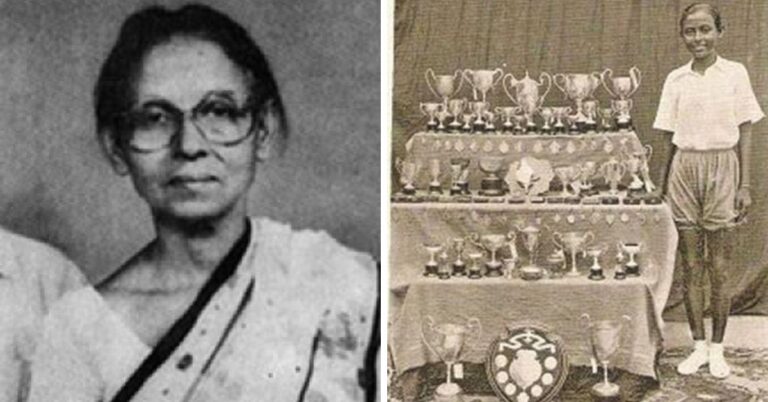![]()
In the annals of undivided Bengal, Ila Mitra is remembered not just as a brilliant athlete but as “Rani Ma,” the queen mother who stood at the helm of one of the region’s most significant peasant movements, the Tebhaga Uprising. Born into a privileged family in 1925, her journey took an unexpected and transformative turn, moving from a world of accolades in sports to one of brutal political struggle. Her story is one of resilience, pain, and the relentless pursuit of justice — a legacy that deserves recognition across generations.
Ila Mitra: The Athlete Who Could Have Represented India
Ila Mitra was born in Calcutta (now Kolkata) as the eldest of six children in a prosperous family. Her father, Nagendranath Sen, the Accountant General of Bengal, instilled a love for sports in her from a young age. Under his encouragement, Ila excelled in swimming, basketball, and track, becoming a celebrated athlete in Bengal. By 1937, Ila was a junior champion, collecting over 47 trophies, and by 1940, at the age of 15, she had been shortlisted to represent India at the Olympics.
However, her promising sports career was abruptly halted when the 1940 Olympics were canceled due to World War II. Though Ila’s dreams of competing on the global stage never materialized, this was only the beginning of a much more profound and turbulent journey.
A Shift Toward Activism: From Athlete to Rani Ma
While continuing her education at Bethune College, Ila’s life took a political turn. She married Ramendranath Mitra, a member of the Communist Party of India (CPI). Through her association with her husband and her own growing political consciousness, she began actively participating in social justice causes. Ila joined the Mahila Atma Raksha Samiti (MARS), an organization created to protect women during the chaotic times of war, hunger, and poverty. Her work with the peasant community soon extended to the Tebhaga Movement, a peasant uprising aimed at reducing the heavy burden on Bengal’s farmers.
The movement demanded that the sharecroppers, who were forced to give up half of their harvest to landlords, be allowed to keep two-thirds of it. Thousands of landless laborers and marginalized groups like the Santhal community rallied under her leadership.
Tebhaga Uprising and Its Brutal Aftermath
Ila Mitra’s involvement in the Tebhaga Uprising culminated in her leading a protest in Nachole in 1950. However, the peaceful movement quickly turned violent when police were called to suppress it, and four policemen were killed. Ila was forced to flee, disguising herself as a Santhal woman. Despite her efforts to escape, she was arrested and subjected to unimaginable torture.
Ila was brutally raped and tortured for days by the police. Her ordeal, which included being beaten, deprived of food and water, and assaulted with foreign objects, left her severely injured. It was only after four days of torment that a compassionate jail warden arranged for medical treatment.
Surviving Torture, Rebuilding Life
Ila’s horrific experience did not break her spirit. She survived and was sentenced to seven years in jail, not for the murders, but for inciting violence. Despite her suffering, Ila emerged stronger and more determined after her release in 1954. She completed her Master’s degree in Bangla Literature and worked as a teacher, while also representing the Maniktala constituency in the West Bengal Legislative Assembly until 1977.
Her commitment to justice never wavered, even as she battled long-term health issues caused by her imprisonment. Ila continued to be a pillar of strength for Bengal’s marginalized communities, remembered not just as a political leader but as someone who, through sheer will, defied both societal and personal limitations.
A Lasting Legacy of Strength and Resistance
Although she passed away in 2002, Ila Mitra’s legacy continues to inspire activists, feminists, and political leaders alike. Even in her later years, she remained deeply involved in party politics, holding forth on what she saw as the party’s shortcomings. For Ila, the struggle for justice and fairness was never about personal glory but about standing for what was right.
Her athletic background, though long in the past, stayed with her throughout her life. Even in her later years, Ila would wake up at dawn to go swimming, maintaining the physical discipline that had once made her a sports star. Her ability to endure, both physically and mentally, was, in her own words, the reason she survived the unimaginable torture inflicted upon her.
Her story, which spans the world of sports, political activism, and social justice, is one that reflects the turbulent times in which she lived and the enduring spirit of a woman who fought for a cause far greater than herself.
Ila Mitra, often overshadowed by other historical figures, deserves to be remembered as a pioneer of both physical and political resilience. From an Olympic hopeful to a revolutionary figure, her journey illustrates the complex layers of personal and national identity in a time of struggle. She was the “Rani Ma” not only to the peasants of Bengal but to all who seek justice in the face of oppression.
Reference:







